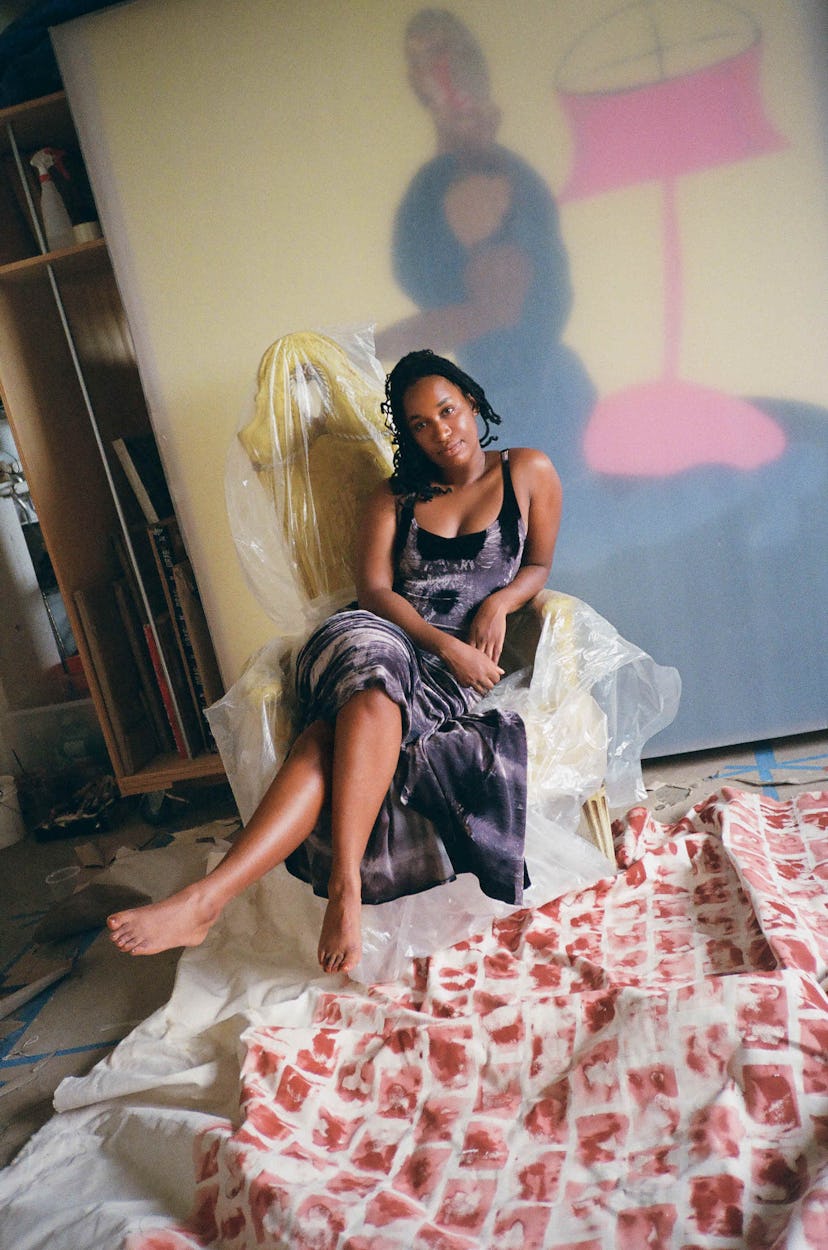Tschabalala Self’s Paintings Celebrate the Beauty of Everyday Black Life
The 30-year-old artist's solo exhibition at Galerie Eva Presenhuber explores themes of nostalgia, identity and intimacy.

“There is so much hope and exceptionalism entwined in the American identity,” says Tschabalala Self, the day after Election Day. There’s a weariness in her voice that likely has as much to do with the protracted presidential race as it does with being in the final stretch of preparations for her solo exhibition at Galerie Eva Presenhuber in Lower Manhattan. The 30-year-old artist is perched in the gallery’s back room, FaceTiming from the director’s desk where she sits surrounded by framed prints of fellow artists Lee Jaffe, Koo Jeong A and Wyatt Kahn, all of whom have had their work hung in the gallery’s Great Jones Street space. “American identity is a fantasy that our citizens treasure about themselves,” Self continues. “But our reality tells a different story.”
In the days since our conversation, Self’s exhibition, Cotton Mouth, opened to the public and the United States elected Joe Biden president, his victory secured in large part by Black voters in battleground states. Self is well-aware of the resonance of her exhibition’s title, which simultaneously calls to mind the nation’s historic dependence on the exploitation of Black Americans and the sensation of a mouth too dry to speak. This sentiment, of the simultaneous power and weight of Black American identity, is refracted throughout this collection of larger-than-life paintings, sculptures and drawings that focus on the Black female body.
Tschabalala Self, Sprewell, 2020. Photo by Matt Grubb, courtesy the artist and Galerie Eva Presenhuber, Zurich / New York.
Though Cotton Mouth’s subject matter has reverberated in the public sphere in recent months, themes of Black nostalgia, domesticity and intimacy have long been present in Self’s work. A Harlem native, Self’s community was often cast aside by the optimistic American narrative she previously described. “I never felt like there was an image or a narrative that held up a mirror to me,’” Self shrugs. This feeling launched an artistic practice fixated on celebrating the minutiae of Black life. “To finally see something that clearly and respectfully reflected my experience, I had to make my own stories.”
In Self’s stories, Black women command large, colorful canvases. They are caught in private, passing moments—in lively conversation with male counterparts, in brief respite on a park bench, or sitting naked, their bodies kaleidoscopes of rippling flesh. Self considers herself a painter above all else, although her canvases are amalgams of newspaper, old sheets, and discarded clothing salvaged from her mother’s fabric collection. On the floor of her New Haven, Connecticut studio, Self dons a pair of knee pads and sifts through these fragments and the carcasses of other abandoned projects until a narrative emerges from the detritus. After weeks of stitching and affixing, a piece is complete.
In the five years since her graduation from the Yale School of Art, Self has exhibited her unflinchingly personal and whimsical works to increasing acclaim at institutions including ICA Boston, Philadelphia Museum of Art and MoMA PS1. Her mixed-media collages and sculptures have been collected by the Los Angeles County Museum of Art and the Art Institute of Chicago.
Installation view, Tschabalala Self: Cotton Mouth, Eva Presenhuber, New York, 2020. Photo by Matt Grubb, courtesy the artist and Galerie Eva Presenhuber, Zurich / New York.
These accolades have secured Self’s place among a growing cadre of female artists of color, including Mickalene Thomas, Wangechi Mutu and Sable Elyse Smith, whose work both illuminates intimate moments within Black communities and speaks directly to Black audiences. But changing the art world’s conception of Blackness is not necessarily Self’s intention. “There’s definitely a disconnect between the communities that interact with my work and the community that the work is geared towards,” she observes.
Indeed, for some, the work displayed in Cotton Mouth is layered with nostalgia-triggering detail: In “Lil’ Mama 2,” a young girl strikes a pose with a fringe of eye-catching orange tulle fringe around her ankles—a gestural flourish that harkens to the easter socks that Self’s mother dressed her in on special occasions. In “Sprewell” a burly man wears a jersey in homage to the N.B.A. player, a repurposed pair of the artist’s own Y Project jeans and Yeezys (her boyfriend’s obsession) made from newspaper and paint. “For the people I grew up with, there’s an immediate recognition—of the Easter socks, of the Sprewell jersey. They see the work and just know. But when it enters the larger arts community, there’s a lot of confusion around those details.”
Tschabalala Self, Nate the Snake, 2020. Photo by Matt Grubb, courtesy the artist and Galerie Eva Presenhuber, Zurich / New York.
Self is used to making references that the art world misses. At Cotton Mouth, a stream-of-consciousness recording of Self’s voice is piped through the gallery speakers, a narration of the artist’s own ideation process: “In Black pop culture,” Self muses on the tape, “fiction and fact become collapsed into one cohesive narrative.” The exhibition reveals Self’s painstaking efforts to assign a visual language to that collapsing—of Black creativity with mass culture’s insatiable appetite, of the artist’s representation of personal experience with the outside forces that assign the work’s value. Cotton Mouth lays these dynamics bare, turning viewers into voyeurs and putting tired representations of Blackness into conversation with richly textured realities. “A new America does exist,” Self pledges on the overhead speaker, “Black America does exist.”